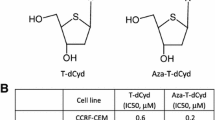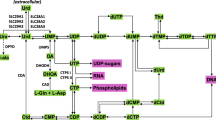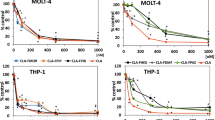Summary
3-Deazaguanine (3-DG), a purine analogue, has unusual antitumor activity against experimental mammary tumor models and a number of other solid tumors. Others have shown that mutant CHO cells deficient in hypoxanthine guanine phosphoribosyl transferase (HGPRTase) or adenine phosphoribosyl transferase (APRTase) are resistant to 3-DG. We developed a L1210 cell line resistant to 3-DG, L1210/3-DG, by subculturing the parent L1210/0 cells in the presence of increasing concentrations of 3-DG. The IC50 was 3.5 μM and 620 μM for L1210/0 and L1210/3-DG, respectively. Cytotoxicity studies proved the resistance to be stable. Examination of the baseline-specific activity of HGPRTase and APRTase showed that the former was 118-fold lower in L1210/3-DG than in L1210/0, and the latter demonstrated no difference. A 4-h treatment of the cell lines at IC50 doses showed 48% and 23% reductions in IMP dehydrogenase in L1210/0 and L1210/3-DG, respectively. The rate of de novo purine biosynthesis was studied by using [14C]formic acid. Formate flux increased 2-fold in L1210/3DG in concert with the observed deficiency of HGPRTase in the cell line. 3-DG uptake was studied with [14C]-labelled compound. The total radioactivity was 9-fold higher in L1210/0 than in L1210/3-DG at 2 h. Subsequent chromatographic separation of radioactivity showed the 3-DG and 3-deazaguanosine pools of the drug to be equal in both lines. However, 3-DG nucleotide pools at 1 min and 2 h were 2.5-fold and 16-fold lower, respectively, in L1210/3-DG than in L1210/0. 3-DG incorporation studies with radiolabelled drug demonstrated that 3-deazaguanine is incorporated in the acid-insoluble fraction of the cell. These studies conclude that HGPRTase, and not APRTase, is required for the activation of drug. Inhibition of IMP dehydrogenase is partially responsible for antitumor activity of the drug. The incorporation of drug into nucleic acids may be a major mechanism for its antitumor activity. Further studies using a cloned cDNA probe for hypoxanthine guanine phosphoribosyltransferase (HGPRT) demonstrated no change in the DNA arrangements of the L1210/3-DG cell line, and Northern blot analysis showed approximately equal expression of mRNA in both cell lines.
Similar content being viewed by others
Abbreviations
- APRTase:
-
adenine phosphoribosyltransferase
- HGPRTase:
-
Hypoxanthine guanine phosphoribosyltransferase
- IMPD:
-
Inosine mono-phosphate dehydrogenase
- PRPP:
-
5-Phosphorylribose-1-pyrophosphate
- AOPCP:
-
α, β-Methyleneadenosine 5′-diphosphate
- NAD:
-
Nicotineamide dinucleotide
- EDTA:
-
Ethylenediamine tetra acetic acid
References
Allen LB, Huffman JH, Cook PD, Meyer RB, Robins RK, Sidwell RW (1977) Antiviral activity of 3-deazaguanine. Antimicrob Agents Chemother 12: 114–119
Birnhoim HC, Doly J (1979) A rapid alkaline extraction procedure for screening recombinant plasmid DNA. Nucleic Acids Res 7: 1513
Bradford M (1976) A rapid and sensitive method for the quantitation of microgram quantities of protien utilizing the principale of protien dye binding. Anal Biochem 72: 248
Cook PD, Allen LB, Streeter DG, Huffman JH, Sidwell RW, Robins RK (1978) Synthesis and antiviral and enzymatic properties of certain 3-deazaguanies and their imidazolecarboxamide precoursers. J Med Chem 21: 1212–1218
Drouin J (1980) Cloning of human mitochondrial DNA in E. coli. J Mol Biol 140: 15
Favaloro J, Treismar R, Kamen R (1980) Transcription maps of polyoma virusspecific RNA: analysis by two-dimensional nuclease 31 gel mapping. Methods Enzymol 65: 718
Jayaram HN, Ardalan B, Deas M, Johnson RK (1985) Studies on the mechanism of sensitivity or resistance to L-(α5-5S)-αamino-3 chloro, 4,5-dihydro-5-isoxazole acetic acid (Acivicin). Cancer Res 45: 207–212
Khwaja TA (1982) 3-Deazaguanine, a candidate drug for chemotherapy of breast carcinoma? Cancer Treat Rep 66: 1853–1858
Khwaja TA, Varven JC (1976) 3-Deazaguanine, a potent inhibitor of mammary adenocarcinoma R3230AC and mammary adenocarcinoma 13762. Proc Am Assoc Cancer Res 17: 200
Khwaja TA, Kigwana L, Meyer RB, Robins RK (1972) 3-Deazaguanine, a new purine analog exhibiting antitumor activity. Proc Am Assoc Cancer Res 16: 162
Khwaja TA, Momparler L, Varven JC, Mian AM (1979) Studies on antitumor activity of 3-deazaguanine. Proc Am Assoc Cancer Res 20: 152
Konecki DS, Brennand J, Fuscoe JC, Caskey CT, Chinault AC (1982) Hypoxanthine-guanine phosphoribosyltransferase genes of mouse and Chinese hamster: construction and sequence analysis of cDNA recombinants. Nucleic Acids Res 10: 6763
Marmur J, Doty P (1962) Determination of the base composition of deoxyribonucleic acid from its thermal denaturation temperature. J Mol Biol 5: 109
Matthews TR, Dougherty PF, Cook PD (1976) Interscience conference on antimicrobial agents and chemotherapy, Chicago, Illinois (Abstract 426)
Matthews TR, Yotter DW, Cook PD (1976) Interscience conference on antimicrobial agents and chemotherapy, Chicago, Illinois (Abstract 425)
Proffitt RT, Pathak VK, Villacorte DG, Presant CA (1983) Sensitive radiochemical assay for inosine 5′-monophosphate dehydrogenase and determination of activity in murine tumor and tissue extracts. Cancer Res 43: 1620
Rivert RS, Irwin D, Mandel HG (1982) 3-Deazaguanine inhibition of initiation of translation in L1210. Cancer Res 42: 4039
Saunders PP, Chao LY (1979) Mechanism of action of 3-deazaguanine and 3-deazaguanosine in mammalian cells in vitro. Proc Am Assoc Cancer Res 20: 222
Saunders PP, Chao LY, Loo TL, Robins RK (1981) Actions of 3-deazaguanine and 3-deazaguanosine on variant lines of Chinese hamster ovary cells. Biochem Pharmacol 30: 2374–2376
Streeter DG, Koyama HHD (1976) Inhibition of purine nucleotide biosynthesis of 3-deazaguanine, its nucleoside and 5′-nucleotide. Biochem Pharmacol 25: 2413–2415
Schwartz P, Hammond D, Khwaja TA (1977) Biochemical pharmacology of 3-deazaguanine. Proc Am Assoc Cancer Res 18: 153
Southern E (1975) Detection of specific sequences among DNA fragments separated by gel electrophoresis. J Mol Biol 98: 503
Author information
Authors and Affiliations
Additional information
Supported in part by Warner-Lambert Company, Ann Arbor, Michigan
Rights and permissions
About this article
Cite this article
Singh, G., Luna, M.K. & Ardalan, B. Studies on the mechanism of 3-deazaguanine cytotoxicity in L1210-sensitive and -resistant cell lines. Cancer Chemother. Pharmacol. 22, 191–196 (1988). https://doi.org/10.1007/BF00273409
Received:
Accepted:
Issue Date:
DOI: https://doi.org/10.1007/BF00273409




